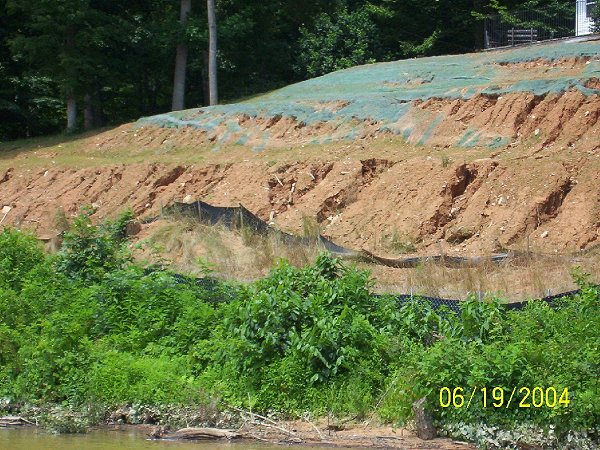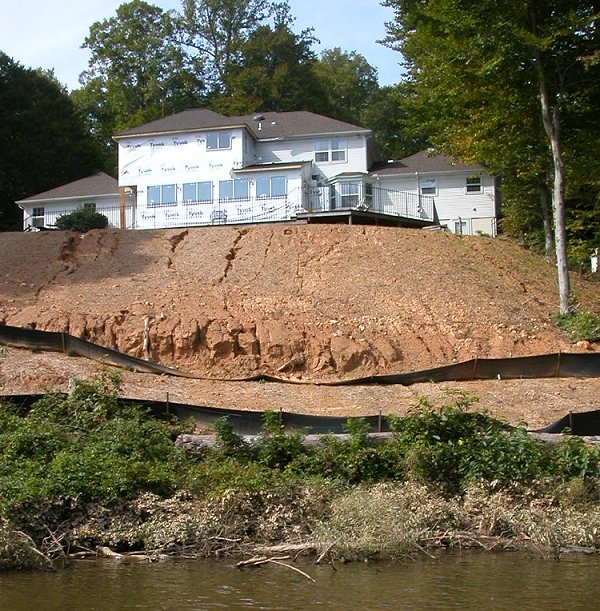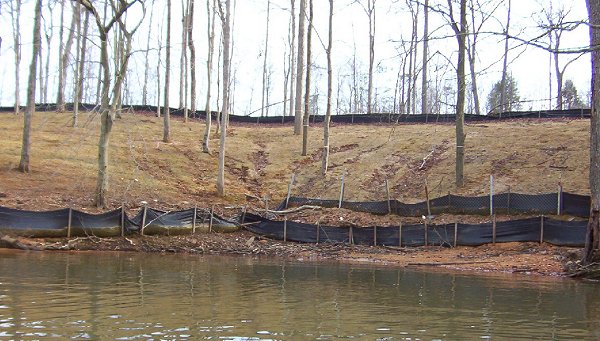
Think this silt fence will protect the reservoir from muddy runoff in a summer thunderstorm?


Many Prince William residents are concerned with increased protection for the Occoquan Reservoir. From the Occoquan Reservoir shoreline to the headwaters in Gainesville, citizens at community meetings, workshops, public hearings and other public events frequently express concern about adequate protection of the Reservoir and are especially interested in preventative measures.
The Prince William Conservation Alliance receives many telephone calls from citizens in east Prince William who are looking for contact information to report clearing activities in the RPA areas along the Reservoir. Generally, these calls occur on Saturday mornings. Without a weekend hotline to Local Contacts, many complaints are received only after the damage is done.
Many citizens also express frustration over the length of time required to both address intrusions into the protected buffer area and mitigate damage to identified areas. Confusion over agency responsibility for infractions along the Reservoir shoreline generates some of this frustration. We hope that the updated regulations will help clear up these gray areas.
Although some recent violations in Prince William have been dramatic, it is regrettable that these few instances color the efforts of the majority. The majority of Prince William homeowners are concerned with protecting the Occoquan Reservoir, understand the value of this important natural resource and follow good stewardship practices.
Adoption of the Fairfax County Water Service Authority regulations, in conjunction with related outreach programs, emphasizes the importance of the Occoquan Reservoir to the Northern Virginia region and can help residents better understand the values of landowner stewardship goals.

In the 1950s, far-sighted Fairfax citizens and government, concerned by the threat of urban sprawl in Northern Virginia, worked together to protect 5,000 acres along the Bull Run-Occoquan River stream valley. This valuable conservation area preserves the marshes, forests and shoreline of the Occoquan Reservoir. In 1982, Fairfax continued to focus on preventative strategies to protect our water supply and downzoned 41,000 acres of land within the Reservoir watershed.
Initial recommendations to safeguard the Reservoir included restricting the population within the watershed area to 100,000 people. Today, nearly 400,000 people live in the Occoquan Reservoir watershed. About 40% of these people live in Prince William. More than half of Prince William residents depend directly on the Occoquan Reservoir for clean drinking water. Additional public water users, mostly in west Prince William, use a mix of water from the Occoquan Reservoir and the Potomac River. The Occoquan Reservoir is critically important to Prince William residents.
About two-thirds of Prince William lands drain into the Occoquan River, with nearly 40% draining directly into the Reservoir. Prince William land uses directly impact the Occoquan Reservoir. Prince William is critically important to the Occoquan Reservoir.
The Fairfax County Water Authority (FCWA), responsible for providing clean drinking water to over 1.2 million Northern Virginia residents, has initiated updates to their easement regulations. Prince William landowners along the Occoquan shoreline, concerned that these regulations infringe on their property rights, have raised questions about fairness.
Do the FCWA regulations unfairly target Prince William landowners? These updates, intended to clarify allowed uses within the easement area adjacent to the Occoquan, would affect the 450 homes on Prince William�s Occoquan shoreline. Because Fairfax conserved 5,000 acres of land on the northern side of the Occoquan in the 1950�s, the regulations would affect only about 25 homes on the Fairfax side.
Several options to ensure stakeholder equity are available. For example, Fairfax could follow Prince William�s lead and open their 5,000 acres of conserved land to development. Although this would likely solve Fairfax�s budget issues for the foreseeable future, pollution would increase significantly and public water users would need to fund expensive mitigation projects through increased rates.
Alternately, Prince William could follow Fairfax�s lead and conserve 5,000 acres along the southern side of the Reservoir. Certainly, the costs to do this today would be significantly higher (unpaid bills don�t vanish, they just grow larger). However, this better-late-than-never investment would match Fairfax�s commitment, protect our drinking water supply and eliminate current landowner concerns about fairness issues.
Although the FCWA is getting all the attention right now, their easement area actually winds in and out of the 100-foot buffer area protected under Prince William�s Chesapeake Bay regulations. Because land elevation defines the easement boundary and the Chesapeake Bay buffer measures a linear 100-foot wide area from the shoreline, these regulations overlap. The intent of both regulations is to protect the water body and the requirements are similar.
Prince William�s Chesapeake Bay regulations require all landowners throughout the watershed area to maintain a 100-foot wide undisturbed buffer area adjacent to perennial water bodies. In Nokesville, farm owners are preserving native woody vegetation and building fences to keep horses and cows out of the 100-foot buffer area. Although Nokesville farms lie far upstream from the Reservoir, landowners are expected to comply with these regulations that protect our drinking water supply, the Potomac River and the Chesapeake Bay.
These same rules apply to lands adjacent to the Occoquan, where tree removal within the 100-foot protected buffer can increase homeowner views of the scenic Reservoir. Although most Prince William landowners along the Occoquan shoreline engage in good stewardship practices, a growing number of violations provide visible evidence that these regulations are inconsistently enforced.
Northern Virginia residents need travel no farther than Fountainhead Regional Park, where the view of Prince William�s Occoquan shoreline clearly shows what happens when landowners and government disregard shoreline protections. This embarrassing view of Prince William�s shoreline, visible to all Northern Virginia residents, contributes to Prince William�s regional reputation as a poor steward of natural assets.
Prince William�s long-term lack of capacity to effectively manage either enforcement or equity issues is cause for concern. While Prince William�s Occoquan shoreline landowners are concerned with personal property rights and scenic views of the Reservoir, Northern Virginia homeowners that rely on the Occoquan Reservoir for clean drinking water are considering the impacts that a water supply included on Virginia�s Dirty Waters list will have on their investment.
Prince William has the privilege of sharing the benefits of the Occoquan Reservoir with other Northern Virginia localities. As we tell our teenagers when handing over the keys to the family car, with privilege comes responsibility.
